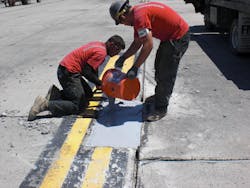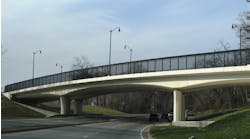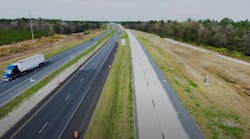Overrun by budget concerns, even airports struggle to keep their runways in a safe, usable condition.
To cost-efficiently keep runways open, more efforts are needed for preservation and repair rather than total replacement. The work needs to be focused on quickly restoring the airport pavements to a high level of service while reducing the costs of reconstruction and heavy rebuilding. Pavement-repair materials need to be permanent to avoid frequent and costly rebuilds.
One of the areas that can cause deterioration in a pavement is unsealed pavement joints and cracks. Materials are needed that will seal the joints and cracks from debris and erosion while allowing the pavement to expand and contract as needed. The material used to repair surrounding concrete must be as long-lasting as the joint- and crack-repair materials. With the use of proper materials, such as preformed compression sealants or two-part polyurethane patching material, money is saved as the airfield pavement is repaired to withstand heavy traffic, weather extremes, debilitating fuels and deicing chemicals.
Repairs to the MidAmerica St. Louis Airport and the Klamath Falls Airport show how use of the proper materials can have a long-lasting, positive effect on the condition of the runway pavement.
Joint effort
When MidAmerica St. Louis Airport’s runways were in need of joint repair, it was only through trial and error that the best long-term repair material became apparent. This airport is located approximately 20 miles east of downtown St. Louis and shares airfield facilities with the Scott Air Force Base.
When the airport was built in the late 1990s, the runway and taxiways were constructed with 16-in.-thick jointed portland cement concrete (PCC) pavements with 25-ft joints and 12-ft asphalt shoulders. Originally, two distinct types of joint sealants were used. The transverse joints were sealed with preformed compression sealants while the longitudinal joints were sealed with silicone joint sealants. All of the joints on the parking aprons also were sealed with compression sealants.
Over time, the silicone joint sealants began to fail, and the airport was spending an ever-increasing amount of resources to continually replace portions of the joint sealant. Recognizing that the expected life of the silicone joint sealant is only eight to10 years, the airport looked to a longer-term solution when replacing these sealants on the runway and taxiway. The compression sealants installed at the same time on the transverse joints were still in good condition, so the decision was made to replace all of the silicone sealants with compression sealants.
In June 2009, a project was let by the Illinois Department of Transportation, Division of Aeronautics, to replace approximately 71,100 linear ft of joint sealant. The project was to include removing and repairing the longitudinal joints on the runway and taxiways and associated spall repair. Since the expected lifetime of the neoprene compression joint sealants is 15 to 20 years and they were still performing well, the preformed compression sealants in the transverse joints did not need to be replaced.
The work began in October 2009 with an expected completion time of 35 calendar days. The joint repair included removing the existing joint sealant by sawing and widening the existing joint, sandblasting to clean the joint, and sealing the joint with a preformed compression joint sealant. The existing joints varied from 3?8 to 1?2 in. and were sawed to a new width of 3?4 in. The new 3?4-in. joint width eliminated any joint width irregularities and allowed for the easy installation of the new compression sealant.
The work required that the runway be shut down for only one week, and various taxiways were closed as work progressed. Although significant rain fell during the construction time period, the repairs using the preformed compression sealants were easy to keep on track, and all work was completed ahead of schedule.
Strength and flexibility
Repairing a runway involves making rapid repairs that minimize downtime. Common repairs include effective and experienced repair of potholes, joint spalling and raveling, repairs around manhole and utility covers, lightning-strike damage, corner cracking and conduit backfilling. Making permanent repairs and choosing permanent repair materials is necessary to minimize future maintenance and minimize foreign object debris problems that can cause airplane damage. A range of repairs may be required in a short period of time, requiring a material that is easy to use and quick to cure.
Often, cementitious or other rigid partial-depth repair products are used to repair spalls in concrete pavements. The problem with these products is that they also are brittle and can crack under direct heavy impact or because they have a different coefficient of expansion than the concrete around them. If the strength and the rate of expansion and contraction of the patching materials significantly differ from the material being repaired, it is inevitable that one or both of the materials will fail. Conversely, asphaltic and other soft-patching materials often lack the strength to hold up to direct traffic impact.
One often-permanent solution is a two-part polyurethane patching material mixed with proprietary aggregates, because it has the ideal combination of strength and elasticity. This type of patching material has been specified and installed on airport runways and highways since 1983. Some of the advantages of using this type of patching material are its high-load-bearing capacity—it handles the weight of C-4s, 747s and heavy truck traffic, and has good antispalling properties. It can resist high impact and repel commonly used airport chemicals. This patching material is flexible, allowing it to deflect as the surrounding concrete expands and contracts, rather than destroying the neighboring concrete.
The extent of the strength and flexibility of this patching material is seen in its use on Klamath Falls Airport.
Piece of success
When the Klamath Falls Airport taxiway repair project was designed and bid, the intent of the project was to use available funds to get the most permanent repair possible. Polyurethane patching material was selected to permanently patch aging Taxiway C pavement as part of the Runway 14-32 Runway Reconstruction project.
Subsequently, a year later the Klamath Falls Airport received funds through the America Recovery and Reinvestment Act to remove and completely replace the same concrete pavement. The pavement and patches had to be broken into manageable pieces to accommodate excavation and removal.
The demolition contractor began his work by repeatedly dropping an 8-ft-wide, 6-ton guillotine hammer onto the two-part-polyurethane repairs and surrounding concrete. The concrete pavement readily broke into small pieces under the blows of a 12,000-lb breaker, but the two-part-polyurethane patching material would not crack. Despite the repeated blows, it never lost its structural integrity and was eventually removed intact with an excavator.
This two-part-polyurethane material produces a resilient compound patch. After curing, it remains flexible enough to withstand a strong impact and tough enough to handle heavy pressure without shattering like typical concrete patches.
“In one area, the concrete buckled next to a long application of the [two-part-polyurethane patching material] after being struck repeatedly by the hammer,” said Bill Hancock, Klamath Falls Airport operations manager. “Not only did the product not crack, it actually retained its adhesion to the concrete and conformed to match the pavement’s new shape. Other repairs with this product remain in use at the airport, and I have confidence they will hold up as well.”
The polyurethane patch material was specified for the 14-32 Runway Reconstruction project by Mead and Hunt, an aviation consulting company. Engineers from the firm’s Santa Rosa, Calif.; Madison, Wis.; and Vancouver, Wash., offices worked closely with the civilian operator and Oregon Air National Guard at the Klamath Falls joint-use facility.
“We needed a patch that would expand and contract in the extreme conditions of the airport’s high desert climate,” said Jon Faucher, Mead and Hunt aviation business unit leader. “The service life of a repair typically lasts longer than other conventional patch material. Knowing this, I was still surprised that a 6-ton hammer couldn’t break it.”
Using the best materials for joint sealing and pavement repairs can greatly extend the life of airport pavements, saving the owner the expense and inconvenience of frequent repairs. Preformed compression joint sealants have a proven longer life than other sealants, which is crucial for the limited downtime on airport runways. When it comes to patching pavement, a two-part polyurethane repair material provides unsurpassed strength and performance to handle direct loading and impact, and the flexibility to prevent further deterioration of the problem concrete.



